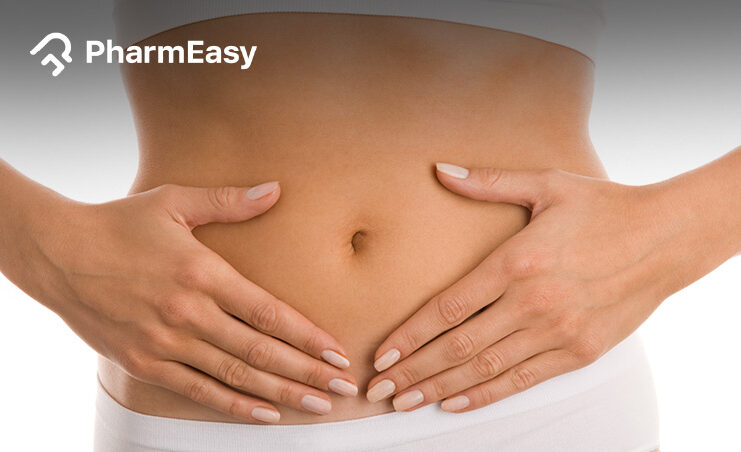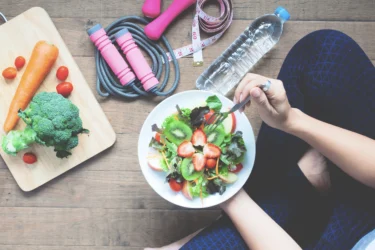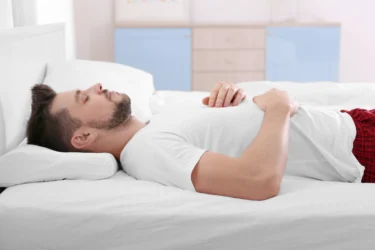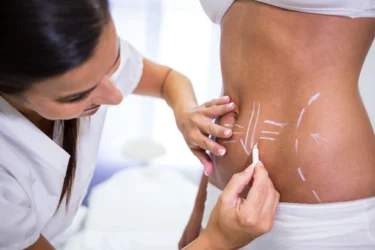Why Is My Upper Stomach Bigger Than My Lower?
By Dr. Nayana Shetty +2 more

Get,

to manage your symptom
Get your,


4 Cr+ families
benefitted

OTP sent to 9988776655



You’ve successfully subscribed to receive
doctor-approved tips on
Whatsapp

Get ready to feel your best.

Hi There,
Download the PharmEasy App now!!


Register to Avail the Offer
Send OTPBy continuing, you agree with our Privacy Policy and Terms and Conditions

Hi There,
Sign up on PharmEasy now!!
Trusted by 4 crore+ families

OTP sent to 9988776655



You have unlocked 25% off on medicines




Code: NU25
By Dr. Nayana Shetty +2 more
Table of Contents
Understanding body composition is essential for maintaining good health and effective weight management. Knowing how the body stores fat can help guide informed decisions about diet and exercise. In this article, we will focus on upper abdominal fat, its common causes, associated health risks, and practical strategies to reduce it. We will also address frequently asked questions to provide a well-rounded understanding of the topic.

The key factors that contribute to the accumulation of upper abdominal fat include:
Bloating can make the upper stomach look larger than the lower stomach1. This may result from a range of issues, including digestive disturbances, poor food combinations, and the consumption of foods that contribute to gas or inflammation.
Digestive problems can lead to abdominal swelling or discomfort. Conditions such as irritable bowel syndrome (IBS), constipation, and excessive gas are common causes. It is advisable to consult a healthcare professional, who can help identify and manage any underlying gastrointestinal issues2.
foods can cause inflammation or swelling in the digestive tract, leading to a bloated abdomen. It is advisable to reduce the intake of items such as alcohol, refined sugar, trans fats, and products made with white flour, as these may contribute to digestive discomfort and bloating.
Combining certain types of foods at the same meal may lead to digestive discomfort and bloating. For instance, consuming complex carbohydrates and proteins together in large quantities can sometimes hinder proper digestion, resulting in a bloated abdomen.
Chronic stress can contribute to fat storage, especially around the abdominal area3. Hormones such as cortisol play a significant role in this process.
Cortisol is a hormone produced by the body in response to stress. Elevated cortisol levels can encourage the storage of visceral fat, particularly in the abdominal region. This may lead to a bloated appearance in the upper stomach area4.
Prolonged stress may contribute to increased abdominal fat and heightened cravings for unhealthy foods. As such, effective stress management is essential for maintaining a healthy weight. Incorporating relaxation techniques, regular physical activity, and mindfulness practices into your routine can help reduce the impact of stress-related weight gain.
After childbirth, some women may notice a protrusion in the upper abdominal area. This can be attributed to conditions such as diastasis recti (separation of the abdominal muscles) and the presence of loose skin.
Diastasis recti is when the abdominal muscles separate during pregnancy. This can result in the abdomen appearing enlarged even after childbirth. Gentle exercises and guided physical therapy may assist in strengthening the core muscles and reducing the separation over time5.
Weight fluctuations during pregnancy can lead to excess loose skin around the upper abdomen, sometimes leaving a noticeable bulge. Over time, a balanced diet and regular exercise may help improve skin elasticity. However, in certain cases where the skin does not tighten naturally, surgical options such as a tummy tuck may be considered5.
During menopause, hormonal changes can lead to more belly fat and is often seen in the upper abdomen6.
As women near menopause, estrogen levels fall and this can affect body fat distribution and may lead to more belly fat6.
.During menopause, a hormonal imbalance marked by elevated oestrogen and reduced progesterone levels can contribute to fat accumulation in the upper abdominal area. Supporting hormonal balance through dietary adjustments, regular physical activity, stress management, and overall lifestyle improvements may help reduce this effect. In some cases, hormone replacement therapy (HRT), when prescribed and monitored by a qualified healthcare professional, may be a suitable option to manage symptoms and assist in reducing upper belly fat.
While it’s not certain if beer leads to belly fat, bingeing on drinks adds to your calorie count. This can make you put on weight7.
Excessive alcohol intake contributes additional calories to the diet, which can lead to weight gain and increased abdominal fat. To avoid developing a so-called “beer belly”, it is advisable to consume alcohol in moderation.
Alcohol is high in empty calories and lacks essential nutrients. Excessive consumption can lead to a significant increase in daily calorie intake, which often contributes to weight gain, particularly in the upper abdominal area.
Intolerance to certain foods can cause bloating and a larger upper stomach. This may be due to gluten, dairy, or other food substances.
Individuals who are intolerant to gluten may experience symptoms such as bloating and gas after consuming gluten-containing grains like wheat, barley, and rye. Adopting a gluten-free diet can often help alleviate these digestive symptoms8.
Many individuals are unable to properly digest lactose, the sugar found in milk and dairy products. Eliminating or reducing dairy intake may help decrease bloating and other digestive discomforts associated with lactose intolerance9.
Certain food intolerances can cause bloating and swelling in the upper abdominal area. Identifying and avoiding these trigger foods may help maintain digestive health. It is important to undertake this process under the guidance of a qualified healthcare professional.
Your genetic makeup plays a significant role in determining where your body stores fat as explained below.
Each individual inherits a unique set of genes that influence body shape and fat distribution. As a result, some people may naturally store more fat in their upper abdominal area due to their genetic predisposition10.
If there is a family history of excess upper abdominal fat, you may be more likely to experience the same. While you cannot change your genetic makeup, maintaining a healthy lifestyle can help mitigate the effects of this predisposition.
Consuming more calories than are expended through physical activity can lead to weight gain, including the accumulation of fat in the abdominal area.
If you consume more calories than your daily activities require, you may gain weight, including an increase in upper abdominal fat.
A sedentary lifestyle reduces the body’s ability to burn excess calories, which can lead to weight gain, including an increase in upper abdominal fat. Regular exercise can help reduce overall body fat, as well as fat stored in the upper stomach area11.
Consuming a diet high in fibre may help in the reduction of abdominal fat and weight. Fibre may promote a prolonged feeling of fullness, which can help decrease daily calorie intake and thus support weight loss.
Dr. Siddharth Gupta, B.A.M.S, M.D
Upper abdominal fat, particularly visceral fat, poses a greater health risk than subcutaneous fat. However, an excess of either type can have negative health consequences.
Visceral fat, located deep within the abdominal cavity, is associated with an increased risk of various chronic health conditions.
Also Read: What Causes Sulphur Burps and How To Stop Them
To reduce abdominal fat, it is important to address its underlying causes. Additionally, adopting appropriate lifestyle changes, including a balanced diet and regular exercise, is essential.

To reduce fat, it is necessary to modify your diet and engage in regular physical exercise.

In certain cases, weight loss medications or supplements may assist in reducing upper abdominal fat.

Meditation and other relaxation practices may help reduce stress levels and reduce weight gain triggered by cortisol17.

Ensuring good sleep quality may help prevent weight gain in the upper abdominal area18.

When all other methods prove ineffective, surgical options may be considered to remove stubborn upper abdominal fat19.
Also Read: Feel Like Throwing Up? What You Should and Shouldn’t Do According to Doctors
Addressing upper stomach fat is vital for your overall health and well-being. Understanding the underlying causes, making healthier lifestyle choices, and exploring effective management strategies can support your weight loss efforts.
Remember, losing fat healthily requires time and patience. Collaborate with your healthcare provider, establish a balanced diet and exercise routine, and maintain a positive outlook throughout the process. With consistent effort, you can improve your health and boost your confidence.
Also Read: Simple Positions To Relieve Gas and Bloating Naturally
Bloating causes the upper stomach to appear enlarged due to excess gas, digestive issues, or inflammation within the gut. Managing bloating through dietary and lifestyle adjustments may help reduce upper stomach fat.
Yes, it is possible to reduce upper stomach fat without surgery. Simply create a calorie deficit through your diet, exercise regularly, and adopt strategies to manage stress.
The rate of weight loss depends on your diet, exercise routine, and metabolic rate. However, gradual progress, approximately 1 to 2 pounds per week is recommended for sustainable and lasting results.
There are no exercises that target upper stomach fat exclusively. However, a balanced fitness programme combining cardio and strength training can help build muscle, burn fat, and reduce overall belly fat, including in the upper abdominal area.
Not all women experience increased belly fat during menopause. However, hormonal changes at this stage can cause weight gain for some. Options such as hormone replacement therapy or lifestyle modifications may help manage this weight gain and reduce upper stomach fat.
Poor posture, such as slouching, can cause the upper abdomen to protrude more prominently than the lower abdomen. Improving posture through exercises and ergonomic adjustments may help in achieving a more balanced appearance.
Yes, a diet high in refined carbohydrates and sugars can lead to bloating and gas accumulation in the upper stomach area. Additionally, consuming more calories than you burn may lead to fat accumulation in this region.
Core-strengthening exercises such as planks, crunches, and leg raises can help tone the abdominal muscles, including the upper stomach area. However, spot reduction is not possible, and overall body fat reduction through a combination of exercise and diet is key.
Genetics influence where your body stores fat, including whether more fat accumulates in the upper or lower abdomen. Understanding your genetic predispositions can help tailor your diet and exercise routines to achieve a more balanced body composition.
Disclaimer: The information provided here is for educational/awareness purposes only and is not intended to be a substitute for medical treatment by a healthcare professional and should not be relied upon to diagnose or treat any medical condition. The reader should consult a registered medical practitioner to determine the appropriateness of the information and before consuming any medication. PharmEasy does not provide any guarantee or warranty (express or implied) regarding the accuracy, adequacy, completeness, legality, reliability or usefulness of the information; and disclaims any liability arising thereof.
Comments

Leave your comment...
You may also like
Comments